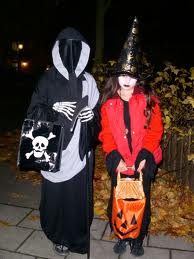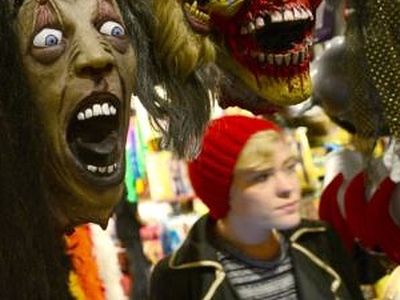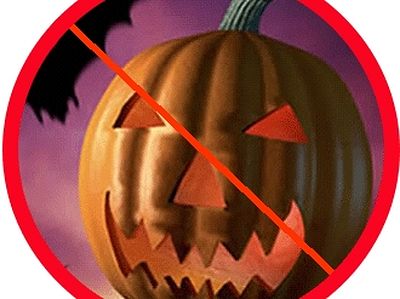
From an Orthodox Christian point of view, we can see many diabolical beliefs and practices associated with this feast, which have endured to this time. On the eve of the New Year's festival, the Druids, who were the priests of the Celtic cult, instructed their people to extinguish all hearth fires and lights. On the evening of the festival, a huge bonfire built from oak branches was ignited (oak was regarded by the Celts as sacred). Upon this fire sacrifices were burned as an offering, in order to appease and cajole Samhain, the Prince of Death. It was also believed that Samhain, being pleased by the offerings, allowed the souls of the dead to return to their homes for a festal visit on this day. It is from this belief that the practice of wandering about in the dark, dressed up in costumes imitating ghosts, witches, hobgoblins, fairies, etc. came about. The living entered into fellowship and communion with the dead by what was, and still is, a ritual act of imitation, through costume and the activity of wandering around in the dark of night, as the souls of the dead were believed to wander.
The dialogue of trick or treat is also an integral part of this system of beliefs and practices. It was believed that the souls of the dead who had entered into the world of darkness, decay and death, and therefore into total communion with and submission to Samhain, bore the affliction of great hunger on their festal visit. Out of this grew the practice of begging, which was also a ritual enactment and imitation of what the Celts believed to be the activities of the souls of the dead on their festal visit. Associated with this is the still further implication that if the souls of the dead and their imitators were not appeased with "treats," i.e. offerings, then the wrath and anger of Samhain would be unleashed through a system of "tricks," i.e. curses. Such is the true meaning of this pagan feast.
It is then evident that for an Orthodox Christian participation at any level is impossible and idolatrous, resulting in a genuine betrayal of God and Church. If we participate in the ritual activity of imitating the dead and wandering in the dark asking for treats or offering them to children, we then have willfully sought fellowship with the dead, whose Lord is not Samhain, but rather Satan. It is to Satan then that these treats are offered, not to children.
There are other practices associated with Halloween from which we must stay away, such as sorcery, fortune telling, divination, games of chance, witchcraft and the carving of an ugly face upon a pumpkin and then placing a lit candle within making it the infamous Jack O'Lantern. The pumpkin (in older days other vegetables were used) was carved by the Celts in imitation of the dead and used to convey the new light (from the sacred oak fire) to the home where the lantern was left burning through the night. This "holy lantern" is nothing more than an imitation of the truly holy votive light (lampada) offered before an icon of Christ and the saints. Even the use and display of the Jack O'Lantern involves participation in this "death" festival honoring Satan.
The Holy Fathers of the first millennium (a time when the Church was one and strictly Orthodox) counteracted this Celtic pagan feast by introducing the Feast of All Saints. It is from this that the term Halloween developed. The word Halloween has its roots in the Old English of All Hallow E'en, i.e. the Eve commemorating all those who were hallowed (sanctified). Unfortunately, either due to a lack of knowledge or understanding, the Celtic pagan feast being celebrated on the same day as the Christian feast of All Saints (in western Christiandom) came to be known as Halloween.
The people who remained pagan and therefore anti-Christian reacted to the Church's attempt to supplant their festival by celebrating this evening with increased fervor. Many of these practices involved desecration and mockery of the Church's reverence for Holy Relics. Holy things, such as crosses and the Reserved Sacrament, were stolen and used in perverse and sacreligious ways. The practice of begging became a system of persecution designed to harass Christians who were, by their beliefs, unable to participate by making offerings to those who served the Lord of Death.
One can see in contemporary Western society that the Western Church's attempt to supplant this pagan festival with a Christian feast failed. How then did something that is so obviously contradictory to the Holy Orthodox faith gain such acceptance among Christian people?
The answer is spiritual apathy and listlessness, which are the spiritual roots of atheism and turning away from God. Today's society urges that Halloween and other such festivities, notwithstanding their apparent pagan and idolatrous origin, are nonetheless harmless and of no consequence. Upon closer consideration, these pagan festivals are the source of destruction of any kind of spiritual foundation and lead to disbelief and outright atheism.
Halloween undermines the very basis of the Church, which was founded on the blood of martyrs who had refused, by giving up their lives, to partake in any form of idolatry.
The holy Church must take a firm stand in counteracting any such (pagan) events. Christ taught us that God is the judge in all our actions and beliefs and that we are either FOR GOD or AGAINST GOD. There is no neutral or middle of the road approach.
Today we witness a revival of satanist cults; we hear of satanic services conducted on Halloween night. Children are kidnapped by satanists for their ritualistic sacrifices. Orthodox clergy are ritualistically killed, as has happened more than once in California. Everywhere Satan reaches out to ensnare as many innocent people as possible. The newsstands are filled with material on spiritualism, supernatural phenomena, seances, prophesies and all kinds of demonically inspired works. These works all serve Satan, for they are not the fruit of the Holy Spirit, but the fruit of the spirit of this world.




